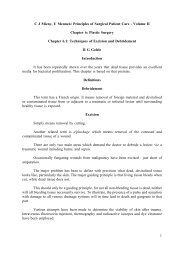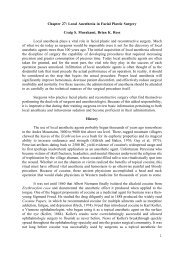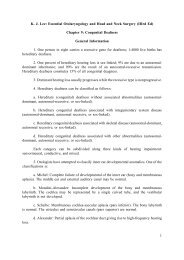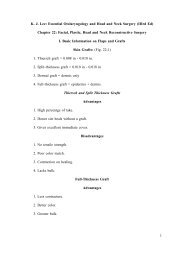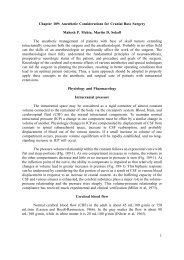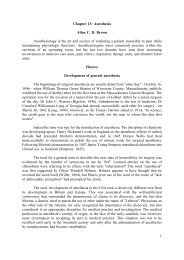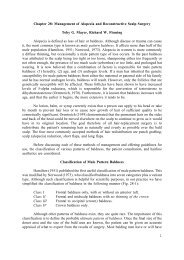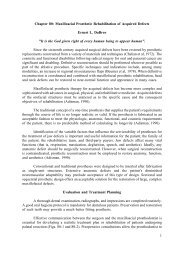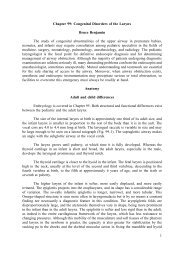1 Chapter 8: Skin Flap Physiology George S. Goding ... - Famona Site
1 Chapter 8: Skin Flap Physiology George S. Goding ... - Famona Site
1 Chapter 8: Skin Flap Physiology George S. Goding ... - Famona Site
You also want an ePaper? Increase the reach of your titles
YUMPU automatically turns print PDFs into web optimized ePapers that Google loves.
study by Kaufman et al (1985) topical ointments were a hindrance to flap survival. Pressure<br />
dressings, however, resulted in increased survival due to improved contact between the flap<br />
and the recipient bed.<br />
The length of time a flap is dependent on its pedicle is determined by the rate of<br />
capillary ingrowth into the transferred tissue. Separation of porcine myocutaneous flaps from<br />
the recipient bed with silastic sheeting resulted in a prolongation of the time needed for<br />
revascularization (Millican and Poole, 1985b). In the same model, revascularization of muscle<br />
flaps required twice as much time as myocutaneous flaps demonstrating the importance of the<br />
dermal and subdermal vascular plexus. A potentially useful manipulation of neovascularization<br />
was demonstrated by Hom et al (1988). Increased flap survival and vascularity was seen when<br />
an endothelial growth supplement was applied in a sustained-release fashion.<br />
Tissue expansion has been demonstrated to increase the size of the transferred flap in<br />
experimental animals and man. Examination of expanded skin in the guinea pig has shown<br />
an increase in the thickness (Austad et al, 1982) and mitotic activity (Francies and Marks,<br />
1977) of the epidermal layer, indicating epidermal proliferation. Blood flow in expanded<br />
tissue is greater than in skin overlying a noninflated expander 1 hour after creation of a<br />
pedicled flap in the porcine model (Marks et al, 1986). The increased blood flow to expanded<br />
skin when compared to delay seems to be short-lived (<strong>Goding</strong> et al, 1988; Ricciardeli et al,<br />
1989). Apart from the acute changes seen with expander manipulation, flap viability and<br />
blood flow in expanded skin appears to be similar to that seen in delayed flaps (Sasaki and<br />
Pang, 1984).<br />
An interesting manipulation to increase survival of thin axial pattern skin flaps was<br />
proposed by Morrison et al (1990). In their study, the femoral artery and vein was implanted<br />
into the subdermal layer of skin in the rabbit model. After 8 to 12 weeks sufficient<br />
neovascularization had occurred to allow creation of a large skin flap based on the transferred<br />
pedicle. If confirmed in other laboratories, this technique may allow greater flexibility in the<br />
design of axial pattern flaps.<br />
Prolonged viability<br />
Protection against harmful agents<br />
The production of free radicals with reperfusion and the return of molecular oxygen<br />
to ischaemic tissue have been a recent focus of experiments attempting to improve flap<br />
survival. This research has focused on decreasing the production of free radicals and using<br />
agents that remove free radicals (free radical scavengers) from the immediate environment.<br />
Preoperative administration of allopurinol (a xanthine oxidase inhibitor) prevents the<br />
increased xanthine oxidase activity seen with acute flap elevation (Im et al, 1984). Improved<br />
survival of dorsal rat flaps has been accomplished with allopurinol when given at high doses<br />
(Angel et al, 1987; Pokorny et al, 1989), with lower doses having no effect (Angel et al,<br />
1987). The high doses required have led to concern about the use of allopurinol to increase<br />
flap survival in humans.<br />
22




